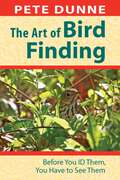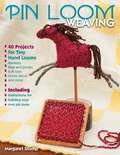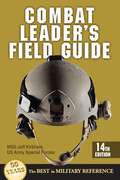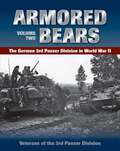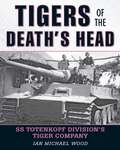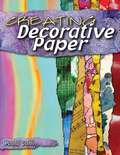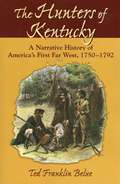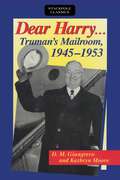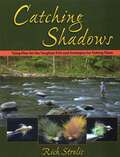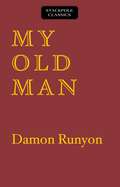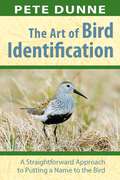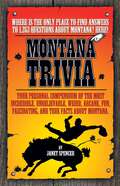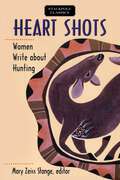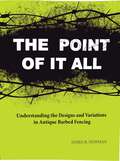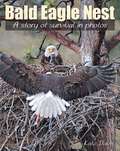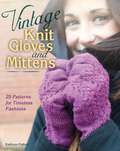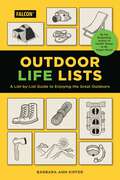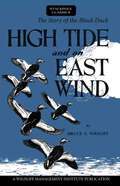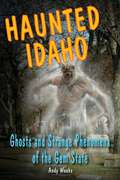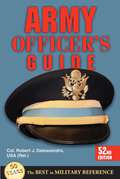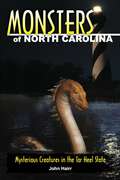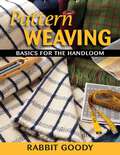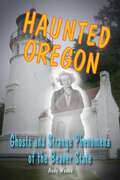- Table View
- List View
Art of Bird Finding
by Pete DunneFilling a gap in the vast literature on birding, Pete Dunne explains in his distinctive style how to find birds--the often-ignored first step in identifying, observing, and listing bird species.
Airman's Guide
by Boone NicollsTop-selling reference guide, revised and updated throughout. Covers the history and customs of the Air Force, standards of conduct, rights and restrictions for servicemembers, training and education, the promotion system, medical care, veterans benefits, and more.
Pin Loom Weaving
by Margaret StumpTiny palm-sized pin looms are making a comeback. Here is the perfect book to get started with this intriguing weaving technique.
Combat Leader's Field Guide
by Jeff KirkhamA guide to the basic skills all soldiers, sailors, and Marines must know to prevail in small-unit dismounted combat operations, including planning, battle drills for offense and defense operations, patrols, construction and emplacement of fighting positions, use of weapons and call for fire, land navigation and map reading, communications, close quarter battle, and tactical combat casualty care.
Armored Bears
by Veterans of the 3rd Panzer DivisionFirst major treatment of the 3rd Panzer Division in English.
Tigers of the Death's Head
by Michael WoodDetailed history of the Tiger company of Nazi Germany's notorious "Death's Head" panzer division of the Waffen-SS.
Creating Decorative Paper
by Paula GuhinPaint, print, layer, and scrape to produce vibrant, creative papers for scrapbooks, greeting cards, collages, gift wrap, book making, and decorating surfaces.
Hunters of Kentucky
by Ted Franklin BelueThe Hunters of Kentucky covers a wide range of frontier existence, from daily life and survival to wars, exploits, and even flora and fauna. the pioneers and their lives are profiled in biographical sketches, giving a rich sampling of the personalities involved in the United States' westward expansion. Author Ted Franklin Belue's colorful, vivid prose brings these long-forgotten frontiersmen to life.Covers the American invasion and settling of the Kentucky frontier Includes such frontier personalities as Daniel Boone, John Redd, Michael Cassidy, and Nicholas Cresswell
Dear Harry (Stackpole Classics)
by Kathryn Moore D. M. GiangrecoAmericans are not particularly shy about letting politicians know what&’s on their minds, and, in Harry Truman, they believed that they had a president they could level with. He even sometimes responded personally to them—especially on subjects he felt strongly about. Today, it seems remarkable that a man who described the presidency as &“the most awesome job in the world&” would take the time to read and respond to White House mail. Truman, however, had an unquenchable thirst for what his everyday Americans&” were thinking, yet distrusted opinion polls. For him, the daily stack of troubles and dreams from places like Skull Bone, Kentucky; Boise, Idaho; and Conway, Florida, provided the next best poll after the voting booth.In Dear Harry, authors D. M. Giangreco and Kathryn Moore include a robust cross section of the thousands of messages sent to Truman. Juxtaposed with informative background essays, these letters provide an undiluted account of the greatest challenges confronting the U.S. during Truman&’s administration, including civil rights, the Marshall Plan, the formation of Israel, the atomic bomb, the McCarthy hearings, the Korean War, and the General McArthur&’s dismissal, which alone solicited more than 90,000 missives. While the majority of the letters are from private citizens, a sprinkling also come from the occasional bombastic senator and a few from the world figures, such as Winston Churchill (who liked to offer advice) and Chaim Weizmann. The names of some correspondents, such as J. Robert Oppenheimer, Upton Sinclair, Gene Tunney, would have been familiar to many of their fellow Americans, While others as diverse as Morey Amsterdam and Barry Goldwater would be better known to future generations.
Catching Shadows
by Rich StrolisNoted commercial tier Rich Strolis shares his most effective patterns as well as the inspiration behind them to help anglers develop their own flies. Features dry flies, emergers, nymphs, and streamers for all seasons.
My Old Man (Stackpole Classics)
by Damon RunyonIn a series of essays, Runyon, reflects on the frank, often outrageous opinions of his &“old man,&” who knows a thing or two about just about everything—and even if he doesn&’t, he&’ll tell you anyway. Damon Runyon's "old man" is neither a small-time Broadway crook, nor a modest Brooklyn Babbitt… He is a salty old commentator on men, women and manners, who says what he thinks with more force and frequency than tact. My Old Man is a classic collection of humorous observations about life from bankers to windbags, and its as relevant and funny today as it was when it was first published in 1939.
Art of Bird Identification
by Pete DunneHow to get good, then better, then even better at identifying birds in the field-and have fun doing it.
Montana Trivia
by Janet SpencerThis fun-filled, fact-filled trivial extravaganza will keep you laughing, keep you learning, and keep you guessing. Trivia Queen Janet Spencer scoured libraries, archives, and museums for the oddest and most obscure figures, facts, and fascination she could find. The perfect campfire companion! Use the book to play a homemade version of Trivial PursuitTM. Keep a copy in your glovebox, or put it in your bathroom!
Heart Shots (Stackpole Classics)
by Mary Zeiss Stange&“A heart shot is what every big game hunter hopes for,&” Editor Mary Zeiss Stange explains in the introduction to Heart Shots, &“that perfect shot placement, whether of bullet or arrow, which ensures a quick, humane kill. A heart shot is also what the best hunting writing has always aimed for—that certain image, or theme, or turn of phrase that strikes to the core of our flesh-and-blood humanity, piercing the tissue-thin membrane between life and death.&”Hunting and writing about it have not commonly been thought of as women&’s work, but today women are hunting and writing about it in unprecedented numbers. This collection of stories by 46 hunters who happen to be female shows us that in fact some women have always hunted, and some have written dazzling accounts of their experiences. What you&’ll find in k to nature and basics and to express in narrative, image, and metaphor the complex meaning of being predator, such impulses are ageless and genderless.There are differences in the way women go about hunting and telling its story. Some are subtle and some are startling. In this marvelous collection a full range of writers from hard-edged realists to contemplative naturalists express the complex thought and emotion that constitute hunting with intelligence and insight. These women are aware of the fact that they are doing something distinctly out of the ordinary. And this is a book distinctly out of the ordinary as well, to be enjoyed, pondered, and savored by women and men alike, all who appreciate a good story well told.[Stories and essays written by Mary Jobe Akeley, Kim Barnes, Nellie Bennett, Durga Bernhard, Courtney Borden, and many more.]
Point of it All: Understanding the Designs and Variations in Antique Barbed Wire
by James R. NewmanThe Point of it All is a thoroughly documented, researched book about the history of the designs of antique barbed fencing. This book describes hundreds of patents and over 2,000 patent design variations found in antique barbed fencing. Varieties such as mild steel barbed wire strands, sheet metal barbed strips, barbed metal rods, and barbed wooden rails. Antique barbed fencing evolved from the wooden fences and plain wire fences of the 1850s. The major antique barbed fencing period occurred from the late 1860s and mid-1870s to early 1900s when inventors in the Midwest and Northeast designed hundreds of new ways to corral livestock. Using US Patent and Trademark Office records and other information sources, the author describes how the inventors considered their patent designs unique, what their purpose was, and what factors influenced the changes in these designs over time. The author describes the common patterns found in the structure and form of these patent designs. Because of the complexity in these designs the author provides a proposed classification system for antique barbed fencing which can be used for sorting, organizing and indexing barbed fencing patents into similar patents and design groups. This book is intended for collectors, farm historians, and those of us who have ripped our pants crossing barbed wire fences.
Bald Eagle Nest
by Kate DavisMore than 100 beautiful color photographs of Bald Eagles in flight and in the nest.
Vintage Knit Gloves and Mittens
by Kathryn FultonA collection of classic, stylish knitted winterwear from the craft's rich past.
Outdoor Life Lists: A List-by-List Guide to Enjoying the Great Outdoors
by Barbara Ann KipferOutdoor Life Lists is an informative celebration of the outdoors. Look inside to find 73 checklists covering the essentials needed and potential extras to consider for enjoying outdoor sports, recreation, and activities. These lists cover the things you need to bring and wear to participate fully and safely in every activity. Also included are informative callout lists that may come in handy in various outdoor situations. To top it off, other callouts offer snippets describing things one may observe during the outdoor activity.
High Tide and an East Wind (Wildlife Management Institute Classics)
by Bruce S. WrightEastern waterfowlers, who know the black duck best, regard this big dusky bird as the top game bird against which all other ducks are measured. In parts of the Northeast this feeling of affection is so strong that in some circles only the black rates the name of "duck." All other species, even the famed canvasback, are "coots," "fish ducks," or are known by even less complimentary titles. Much of this devotion is justified. Without the black duck, wildfowling in much of the thickly settled East would be an unrewarding pastime. Big as a mallard, as wary as a Canada goose, and as handsome in full plumage as any duck that flies, the black duck fills a place on the American sporting scene that could be filled by no other waterfowl. Here is the dramatic story of the life of the black duck, from the time the broods hatch on the spruce-lined ponds of eastern Canada, through the hazardous flights to the southern wintering areas, to the return of the paired birds to the nesting grounds in spring. It is a story told authoritatively by a Canadian scientist whose adult life has been spent in studying the black duck from the fastnesses of its northern breeding grounds in Labrador and Ungava Bay, to the marshes of Louisiana. In this book are facts on the black and other species of waterfowl that will be new to many students of waterfowl as well as to sportsmen. Here also are recommendations for perpetuating the flights of these magnificent game birds.
Haunted Idaho (Haunted Series)
by Andy WeeksA collection of frightening stories from the Gem State.
Panzer Warfare on the Eastern Front
by Hans SchauflerVivid narrative of tank combat on the brutal Eastern Front during World War II.
Army Officer's Guide
by Robert J. Dalessandro David H. Huntoon• Practical advice on Army leadership and command• Fully updated with the latest information for officers of all ranks, branches, and components• Uniforms and insignia, duties and responsibilities, privileges and restrictions, courtesy and customs, posts and organizations, regulations and references• Color images of medals and badges
Monsters of North Carolina (Monsters)
by John HairrBizarre beasts of the Tar Heel State featured in this volume include Skunk Ape, Mystery Primates, Santers and Vampire Beasts, Monstrous Snakes, Giant Insects, Mermaids and Mermen, and Sea Serpents.
Pattern Weaving
by Rabbit GoodyBasic steps needed to weave luxurious fabrics on a foot-treadle handloom.
Haunted Oregon (Haunted Series)
by Andy WeeksVenture into the unexplained phenomena of the Beaver State…if you dare.
